technical specifications Abarth 500 2017 Owner handbook (in English)
[x] Cancel search | Manufacturer: ABARTH, Model Year: 2017, Model line: 500, Model: Abarth 500 2017Pages: 192, PDF Size: 6.46 MB
Page 3 of 192
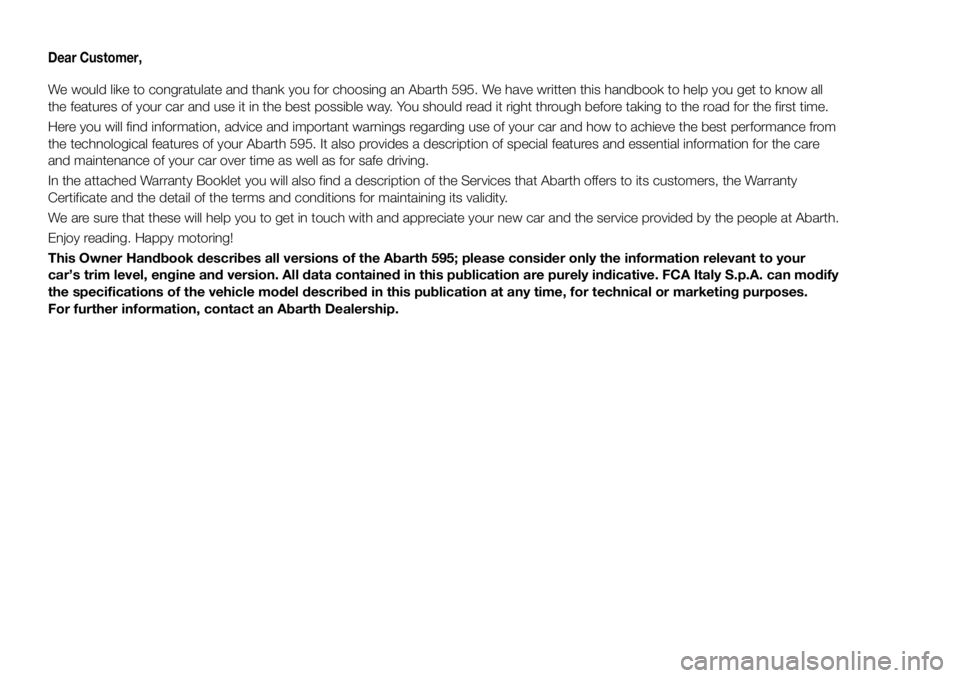
Dear Customer,
We would like to congratulate and thank you for choosing an Abarth 595. We have written this handbook to help you get to know all
the features of your car and use it in the best possible way. You should read it right through before taking to the road for the first time.
Here you will find information, advice and important warnings regarding use of your car and how to achieve the best performance from
the technological features of your Abarth 595. It also provides a description of special features and essential information for the care
and maintenance of your car over time as well as for safe driving.
In the attached Warranty Booklet you will also find a description of the Services that Abarth offers to its customers, the Warranty
Certificate and the detail of the terms and conditions for maintaining its validity.
We are sure that these will help you to get in touch with and appreciate your new car and the service provided by the people at Abarth.
Enjoy reading. Happy motoring!
This Owner Handbook describes all versions of the Abarth 595; please consider only the information relevant to your
car’s trim level, engine and version. All data contained in this publication are purely indicative. FCA Italy S.p.A. can modify
the specifications of the vehicle model described in this publication at any time, for technical or marketing purposes.
For further information, contact an Abarth Dealership.
Page 39 of 192
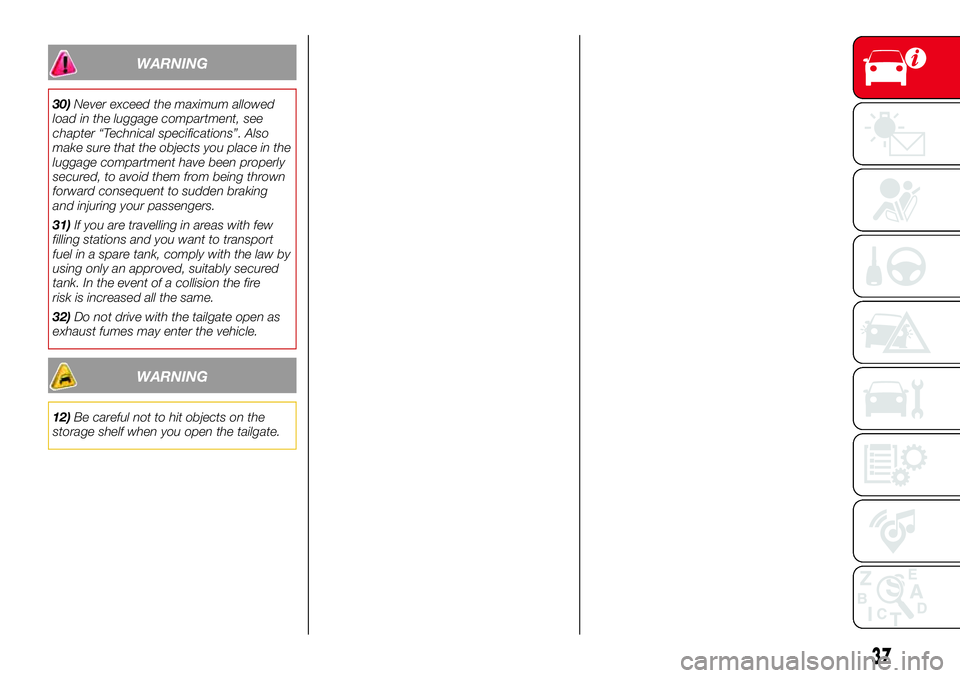
WARNING
30)Never exceed the maximum allowed
load in the luggage compartment, see
chapter “Technical specifications”. Also
make sure that the objects you place in the
luggage compartment have been properly
secured, to avoid them from being thrown
forward consequent to sudden braking
and injuring your passengers.
31)If you are travelling in areas with few
filling stations and you want to transport
fuel in a spare tank, comply with the law by
using only an approved, suitably secured
tank. In the event of a collision the fire
risk is increased all the same.
32)Do not drive with the tailgate open as
exhaust fumes may enter the vehicle.
WARNING
12)Be careful not to hit objects on the
storage shelf when you open the tailgate.
37
Page 64 of 192
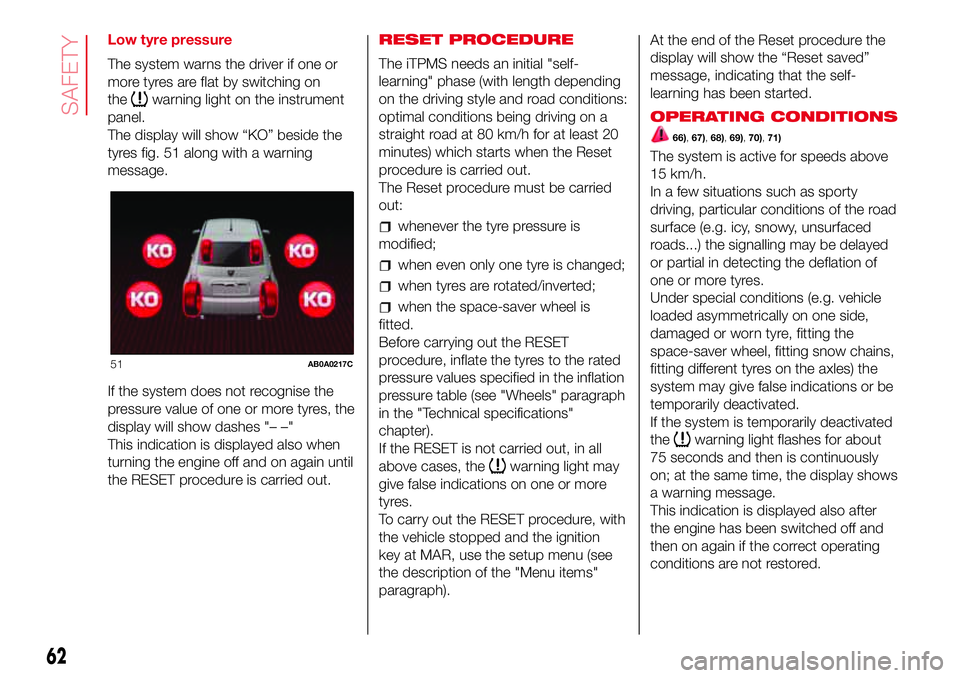
Low tyre pressure
The system warns the driver if one or
more tyres are flat by switching on
the
warning light on the instrument
panel.
The display will show “KO” beside the
tyres fig. 51 along with a warning
message.
If the system does not recognise the
pressure value of one or more tyres, the
display will show dashes "– –"
This indication is displayed also when
turning the engine off and on again until
the RESET procedure is carried out.RESET PROCEDURE
The iTPMS needs an initial "self-
learning" phase (with length depending
on the driving style and road conditions:
optimal conditions being driving on a
straight road at 80 km/h for at least 20
minutes) which starts when the Reset
procedure is carried out.
The Reset procedure must be carried
out:
whenever the tyre pressure is
modified;
when even only one tyre is changed;
when tyres are rotated/inverted;
when the space-saver wheel is
fitted.
Before carrying out the RESET
procedure, inflate the tyres to the rated
pressure values specified in the inflation
pressure table (see "Wheels" paragraph
in the "Technical specifications"
chapter).
If the RESET is not carried out, in all
above cases, the
warning light may
give false indications on one or more
tyres.
To carry out the RESET procedure, with
the vehicle stopped and the ignition
key at MAR, use the setup menu (see
the description of the "Menu items"
paragraph).At the end of the Reset procedure the
display will show the “Reset saved”
message, indicating that the self-
learning has been started.
OPERATING CONDITIONS
66),67),68),69),70),71)
The system is active for speeds above
15 km/h.
In a few situations such as sporty
driving, particular conditions of the road
surface (e.g. icy, snowy, unsurfaced
roads...) the signalling may be delayed
or partial in detecting the deflation of
one or more tyres.
Under special conditions (e.g. vehicle
loaded asymmetrically on one side,
damaged or worn tyre, fitting the
space-saver wheel, fitting snow chains,
fitting different tyres on the axles) the
system may give false indications or be
temporarily deactivated.
If the system is temporarily deactivated
the
warning light flashes for about
75 seconds and then is continuously
on; at the same time, the display shows
a warning message.
This indication is displayed also after
the engine has been switched off and
then on again if the correct operating
conditions are not restored.
51AB0A0217C
62
SAFETY
Page 96 of 192
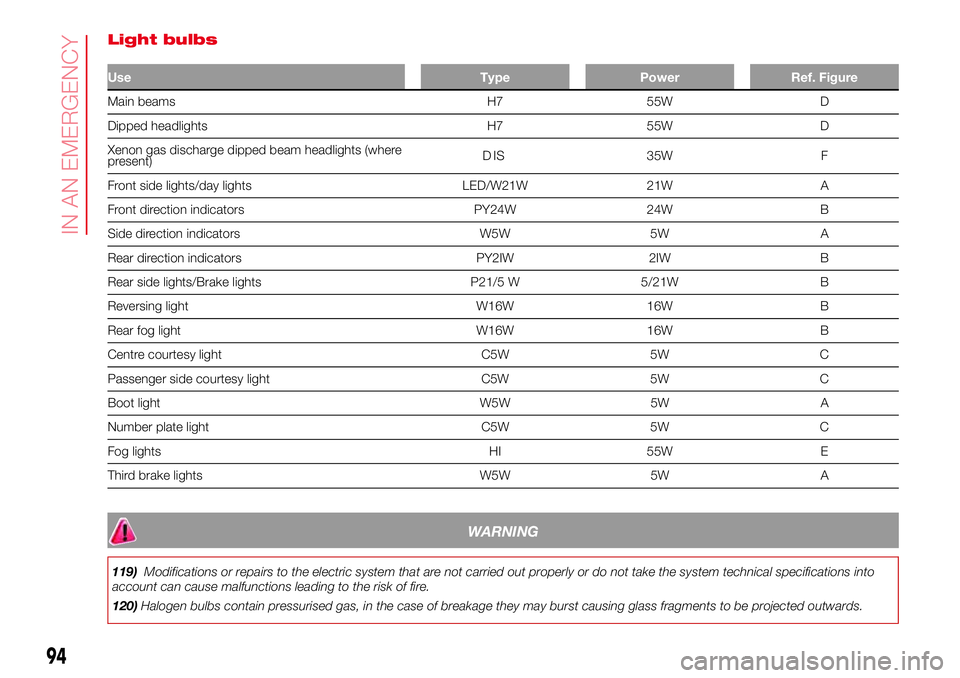
Light bulbs
Use Type Power Ref. Figure
Main beams H7 55W D
Dipped headlights H7 55W D
Xenon gas discharge dipped beam headlights (where
present)DSI 35W F
Front side lights/day lights LED/W21W 21W A
Front direction indicators PY24W 24W B
Side direction indicators W5W 5W A
Rear direction indicators PY2IW 2IW B
Rear side lights/Brake lights P21/5 W 5/21W B
Reversing light W16W 16W B
Rear fog light W16W 16W B
Centre courtesy light C5W 5W C
Passenger side courtesy light C5W 5W C
Boot light W5W 5W A
Number plate light C5W 5W C
Fog lights HI 55W E
Third brake lights W5W 5W A
WARNING
119)Modifications or repairs to the electric system that are not carried out properly or do not take the system technical specifications into
account can cause malfunctions leading to the risk of fire.
120)Halogen bulbs contain pressurised gas, in the case of breakage they may burst causing glass fragments to be projected outwards.
94
IN AN EMERGENCY
Page 120 of 192
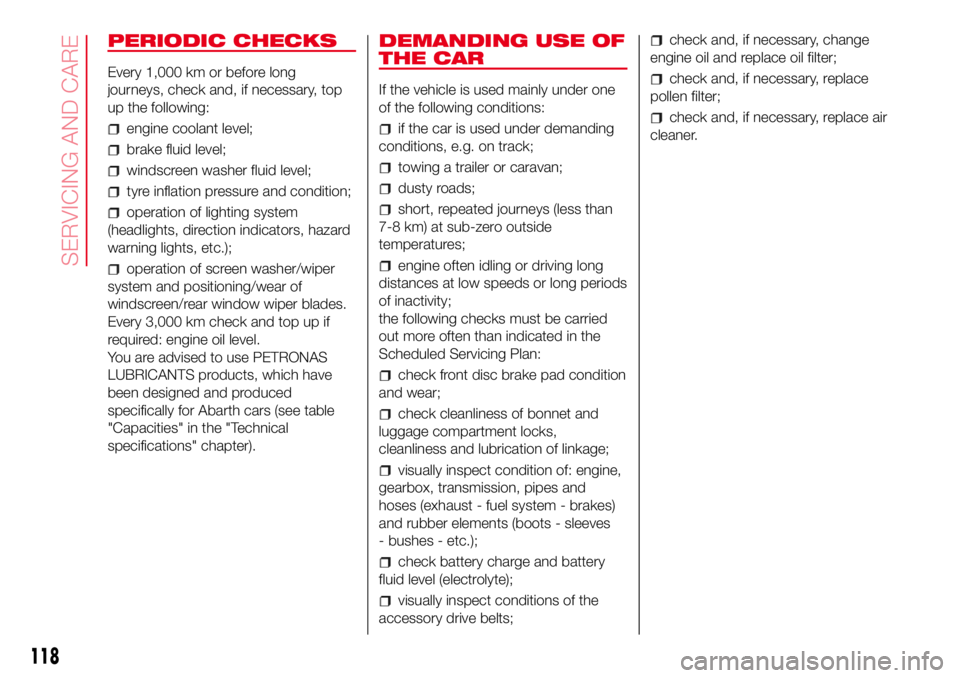
PERIODIC CHECKS
Every 1,000 km or before long
journeys, check and, if necessary, top
up the following:
engine coolant level;
brake fluid level;
windscreen washer fluid level;
tyre inflation pressure and condition;
operation of lighting system
(headlights, direction indicators, hazard
warning lights, etc.);
operation of screen washer/wiper
system and positioning/wear of
windscreen/rear window wiper blades.
Every 3,000 km check and top up if
required: engine oil level.
You are advised to use PETRONAS
LUBRICANTS products, which have
been designed and produced
specifically for Abarth cars (see table
"Capacities" in the "Technical
specifications" chapter).
DEMANDING USE OF
THE CAR
If the vehicle is used mainly under one
of the following conditions:
if the car is used under demanding
conditions, e.g. on track;
towing a trailer or caravan;
dusty roads;
short, repeated journeys (less than
7-8 km) at sub-zero outside
temperatures;
engine often idling or driving long
distances at low speeds or long periods
of inactivity;
the following checks must be carried
out more often than indicated in the
Scheduled Servicing Plan:
check front disc brake pad condition
and wear;
check cleanliness of bonnet and
luggage compartment locks,
cleanliness and lubrication of linkage;
visually inspect condition of: engine,
gearbox, transmission, pipes and
hoses (exhaust - fuel system - brakes)
and rubber elements (boots - sleeves
- bushes - etc.);
check battery charge and battery
fluid level (electrolyte);
visually inspect conditions of the
accessory drive belts;
check and, if necessary, change
engine oil and replace oil filter;
check and, if necessary, replace
pollen filter;
check and, if necessary, replace air
cleaner.
118
SERVICING AND CARE
Page 123 of 192
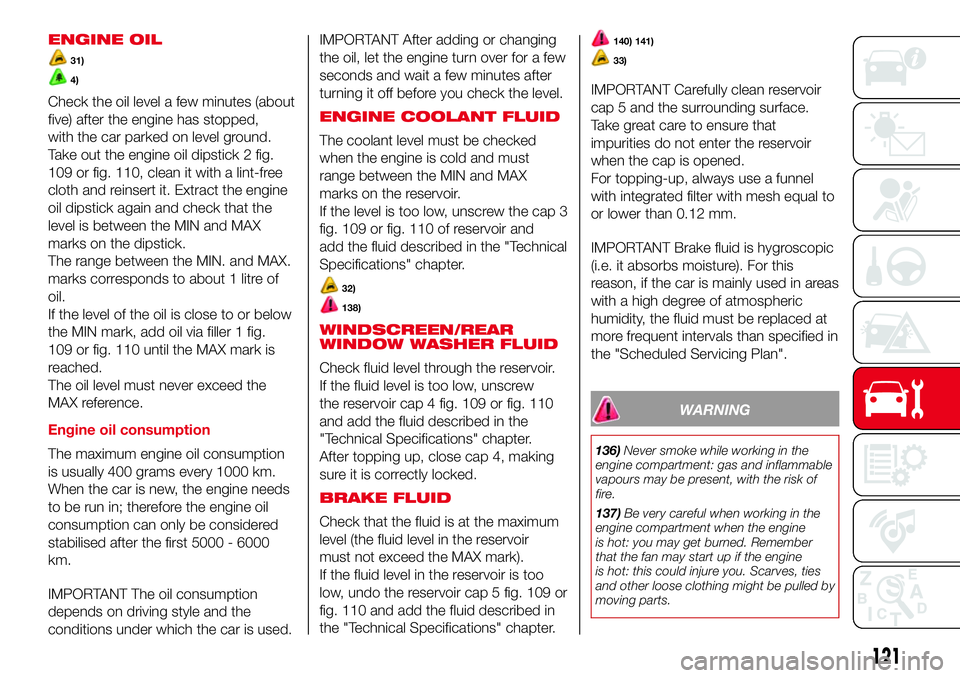
ENGINE OIL
31)
4)
Check the oil level a few minutes (about
five) after the engine has stopped,
with the car parked on level ground.
Take out the engine oil dipstick 2 fig.
109 or fig. 110, clean it with a lint-free
cloth and reinsert it. Extract the engine
oil dipstick again and check that the
level is between the MIN and MAX
marks on the dipstick.
The range between the MIN. and MAX.
marks corresponds to about 1 litre of
oil.
If the level of the oil is close to or below
the MIN mark, add oil via filler 1 fig.
109 or fig. 110 until the MAX mark is
reached.
The oil level must never exceed the
MAX reference.
Engine oil consumption
The maximum engine oil consumption
is usually 400 grams every 1000 km.
When the car is new, the engine needs
to be run in; therefore the engine oil
consumption can only be considered
stabilised after the first 5000 - 6000
km.
IMPORTANT The oil consumption
depends on driving style and the
conditions under which the car is used.IMPORTANT After adding or changing
the oil, let the engine turn over for a few
seconds and wait a few minutes after
turning it off before you check the level.
ENGINE COOLANT FLUID
The coolant level must be checked
when the engine is cold and must
range between the MIN and MAX
marks on the reservoir.
If the level is too low, unscrew the cap 3
fig. 109 or fig. 110 of reservoir and
add the fluid described in the "Technical
Specifications" chapter.
32)
138)
WINDSCREEN/REAR
WINDOW WASHER FLUID
Check fluid level through the reservoir.
If the fluid level is too low, unscrew
the reservoir cap 4 fig. 109 or fig. 110
and add the fluid described in the
"Technical Specifications" chapter.
After topping up, close cap 4, making
sure it is correctly locked.
BRAKE FLUID
Check that the fluid is at the maximum
level (the fluid level in the reservoir
must not exceed the MAX mark).
If the fluid level in the reservoir is too
low, undo the reservoir cap 5 fig. 109 or
fig. 110 and add the fluid described in
the "Technical Specifications" chapter.
140) 141)
33)
IMPORTANT Carefully clean reservoir
cap 5 and the surrounding surface.
Take great care to ensure that
impurities do not enter the reservoir
when the cap is opened.
For topping-up, always use a funnel
with integrated filter with mesh equal to
or lower than 0.12 mm.
IMPORTANT Brake fluid is hygroscopic
(i.e. it absorbs moisture). For this
reason, if the car is mainly used in areas
with a high degree of atmospheric
humidity, the fluid must be replaced at
more frequent intervals than specified in
the "Scheduled Servicing Plan".
WARNING
136)Never smoke while working in the
engine compartment: gas and inflammable
vapours may be present, with the risk of
fire.
137)Be very careful when working in the
engine compartment when the engine
is hot: you may get burned. Remember
that the fan may start up if the engine
is hot: this could injure you. Scarves, ties
and other loose clothing might be pulled by
moving parts.
121
Page 128 of 192
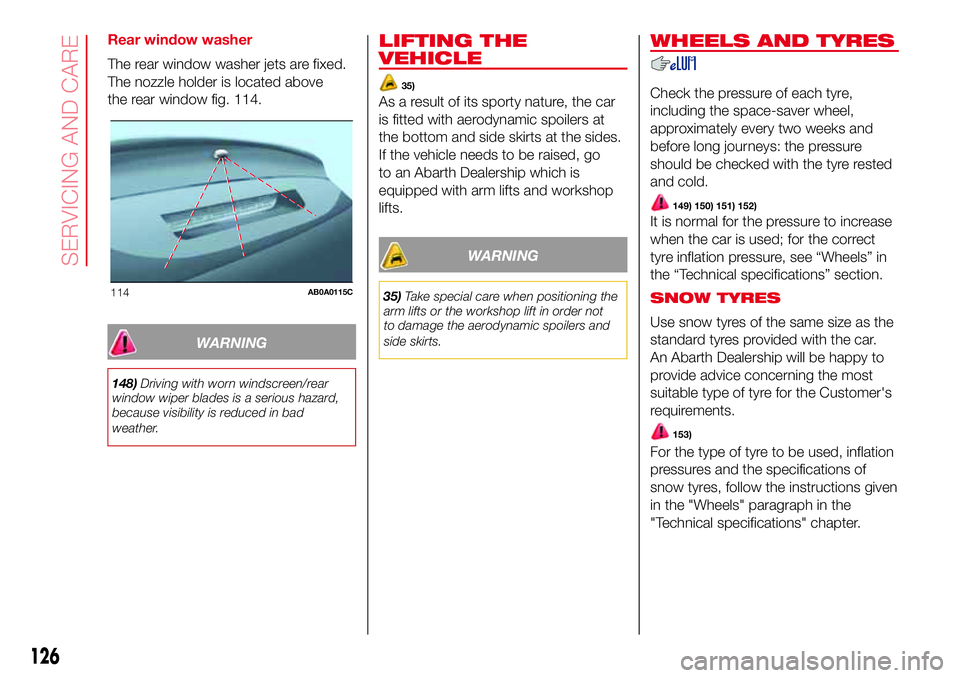
Rear window washer
The rear window washer jets are fixed.
The nozzle holder is located above
the rear window fig. 114.
WARNING
148)Driving with worn windscreen/rear
window wiper blades is a serious hazard,
because visibility is reduced in bad
weather.
LIFTING THE
VEHICLE
35)
As a result of its sporty nature, the car
is fitted with aerodynamic spoilers at
the bottom and side skirts at the sides.
If the vehicle needs to be raised, go
to an Abarth Dealership which is
equipped with arm lifts and workshop
lifts.
WARNING
35)Take special care when positioning the
arm lifts or the workshop lift in order not
to damage the aerodynamic spoilers and
side skirts.
WHEELS AND TYRES
Check the pressure of each tyre,
including the space-saver wheel,
approximately every two weeks and
before long journeys: the pressure
should be checked with the tyre rested
and cold.
149) 150) 151) 152)
It is normal for the pressure to increase
when the car is used; for the correct
tyre inflation pressure, see “Wheels” in
the “Technical specifications” section.
SNOW TYRES
Use snow tyres of the same size as the
standard tyres provided with the car.
An Abarth Dealership will be happy to
provide advice concerning the most
suitable type of tyre for the Customer's
requirements.
153)
For the type of tyre to be used, inflation
pressures and the specifications of
snow tyres, follow the instructions given
in the "Wheels" paragraph in the
"Technical specifications" chapter.
114AB0A0115C
126
SERVICING AND CARE
Page 144 of 192
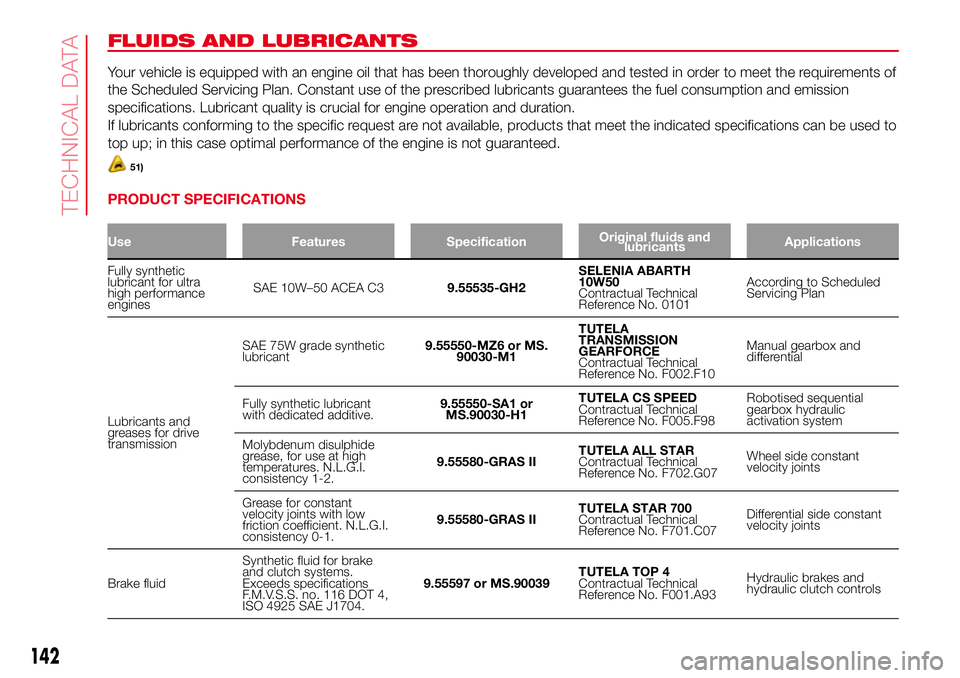
FLUIDS AND LUBRICANTS
Your vehicle is equipped with an engine oil that has been thoroughly developed and tested in order to meet the requirements of
the Scheduled Servicing Plan. Constant use of the prescribed lubricants guarantees the fuel consumption and emission
specifications. Lubricant quality is crucial for engine operation and duration.
If lubricants conforming to the specific request are not available, products that meet the indicated specifications can be used to
top up; in this case optimal performance of the engine is not guaranteed.
51)
PRODUCT SPECIFICATIONS
Use Features SpecificationOriginal fluids and
lubricantsApplications
Fully synthetic
lubricant for ultra
high performance
enginesSAE 10W–50 ACEA C39.55535-GH2SELENIA ABARTH
10W50
Contractual Technical
Reference No. 0101According to Scheduled
Servicing Plan
Lubricants and
greases for drive
transmissionSAE 75W grade synthetic
lubricant9.55550-MZ6 or MS.
90030-M1TUTELA
TRANSMISSION
GEARFORCE
Contractual Technical
Reference No. F002.F10Manual gearbox and
differential
Fully synthetic lubricant
with dedicated additive.9.55550-SA1 or
MS.90030-H1TUTELA CS SPEED
Contractual Technical
Reference No. F005.F98Robotised sequential
gearbox hydraulic
activation system
Molybdenum disulphide
grease, for use at high
temperatures. N.L.G.I.
consistency 1-2.9.55580-GRAS IITUTELA ALL STAR
Contractual Technical
Reference No. F702.G07Wheel side constant
velocity joints
Grease for constant
velocity joints with low
friction coefficient. N.L.G.I.
consistency 0-1.9.55580-GRAS IITUTELA STAR 700
Contractual Technical
Reference No. F701.C07Differential side constant
velocity joints
Brake fluidSynthetic fluid for brake
and clutch systems.
Exceeds specifications
F.M.V.S.S. no. 116 DOT 4,
ISO 4925 SAE J1704.9.55597 or MS.90039TUTELA TOP 4
Contractual Technical
Reference No. F001.A93Hydraulic brakes and
hydraulic clutch controls
142
TECHNICAL DATA
Page 145 of 192
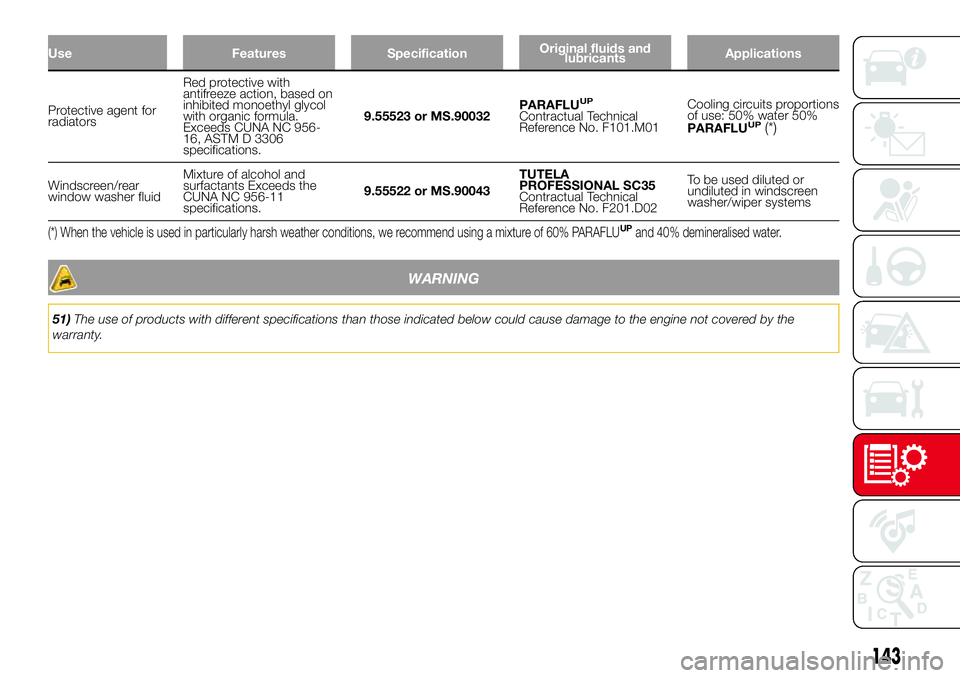
Use Features SpecificationOriginal fluids and
lubricantsApplications
Protective agent for
radiatorsRed protective with
antifreeze action, based on
inhibited monoethyl glycol
with organic formula.
Exceeds CUNA NC 956-
16, ASTM D 3306
specifications.9.55523 or MS.90032PARAFLUUP
Contractual Technical
Reference No. F101.M01Cooling circuits proportions
of use: 50% water 50%
PARAFLUUP(*)
Windscreen/rear
window washer fluidMixture of alcohol and
surfactants Exceeds the
CUNA NC 956-11
specifications.9.55522 or MS.90043TUTELA
PROFESSIONAL SC35
Contractual Technical
Reference No. F201.D02To be used diluted or
undiluted in windscreen
washer/wiper systems
(*) When the vehicle is used in particularly harsh weather conditions, we recommend using a mixture of 60% PARAFLUUPand 40% demineralised water.
WARNING
51)The use of products with different specifications than those indicated below could cause damage to the engine not covered by the
warranty.
143
Page 188 of 192
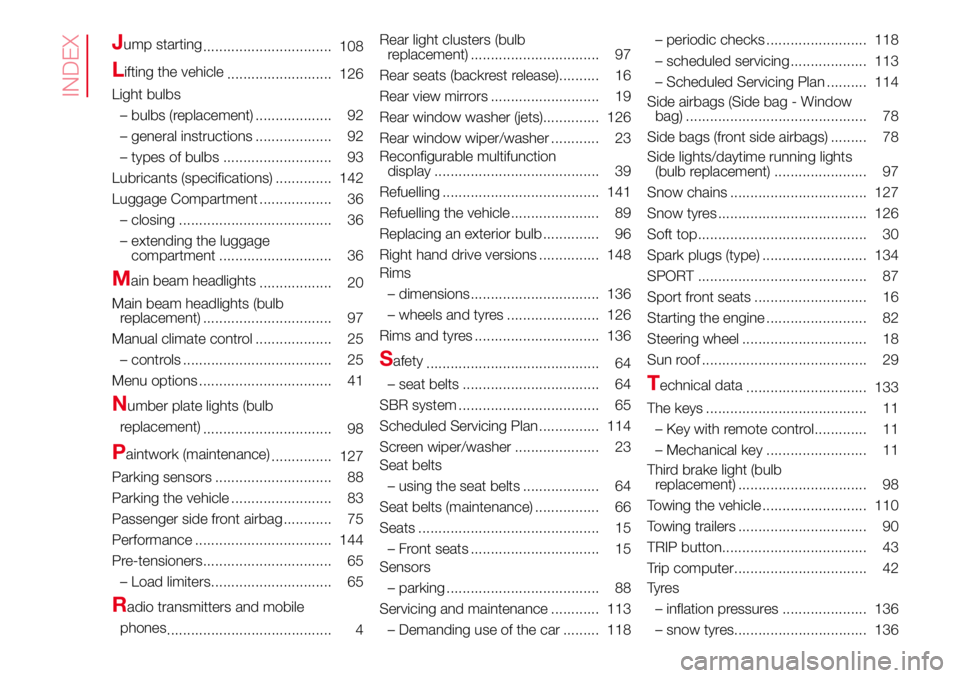
Jump starting
................................ 108
Lifting the vehicle
.......................... 126
Light bulbs
– bulbs (replacement) ................... 92
– general instructions ................... 92
– types of bulbs ........................... 93
Lubricants (specifications) .............. 142
Luggage Compartment .................. 36
– closing ...................................... 36
– extending the luggage
compartment ............................ 36
Main beam headlights
.................. 20
Main beam headlights (bulb
replacement) ................................ 97
Manual climate control ................... 25
– controls ..................................... 25
Menu options ................................. 41
Number plate lights (bulb
replacement)
................................ 98
Paintwork (maintenance)
............... 127
Parking sensors ............................. 88
Parking the vehicle ......................... 83
Passenger side front airbag ............ 75
Performance .................................. 144
Pre-tensioners................................ 65
– Load limiters.............................. 65
Radio transmitters and mobile
phones
......................................... 4Rear light clusters (bulb
replacement) ................................ 97
Rear seats (backrest release).......... 16
Rear view mirrors ........................... 19
Rear window washer (jets).............. 126
Rear window wiper/washer ............ 23
Reconfigurable multifunction
display ......................................... 39
Refuelling ....................................... 141
Refuelling the vehicle ...................... 89
Replacing an exterior bulb .............. 96
Right hand drive versions ............... 148
Rims
– dimensions................................ 136
– wheels and tyres ....................... 126
Rims and tyres ............................... 136
Safety
........................................... 64
– seat belts .................................. 64
SBR system ................................... 65
Scheduled Servicing Plan ............... 114
Screen wiper/washer ..................... 23
Seat belts
– using the seat belts ................... 64
Seat belts (maintenance) ................ 66
Seats ............................................. 15
– Front seats ................................ 15
Sensors
– parking ...................................... 88
Servicing and maintenance ............ 113
– Demanding use of the car ......... 118– periodic checks ......................... 118
– scheduled servicing ................... 113
– Scheduled Servicing Plan .......... 114
Side airbags (Side bag - Window
bag) ............................................. 78
Side bags (front side airbags) ......... 78
Side lights/daytime running lights
(bulb replacement) ....................... 97
Snow chains .................................. 127
Snow tyres ..................................... 126
Soft top.......................................... 30
Spark plugs (type) .......................... 134
SPORT .......................................... 87
Sport front seats ............................ 16
Starting the engine ......................... 82
Steering wheel ............................... 18
Sun roof ......................................... 29
Technical data
.............................. 133
The keys ........................................ 11
– Key with remote control............. 11
– Mechanical key ......................... 11
Third brake light (bulb
replacement) ................................ 98
Towing the vehicle .......................... 110
Towing trailers ................................ 90
TRIP button.................................... 43
Trip computer................................. 42
Ty r e s
– inflation pressures ..................... 136
– snow tyres................................. 136
INDEX